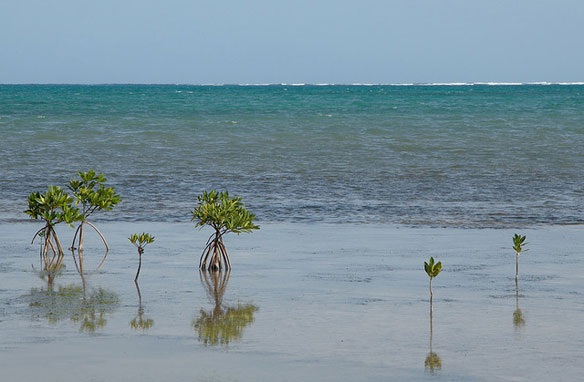
Mangrove, Belize. Photo source: ©© By Claire Tawain
By Repeating Islands
CORAL’s (Coral Reef Alliance) mangrove reforestation project in San Pedro, Belize is thriving. Recent monitoring reports reveal that ninety percent of the mangroves planted by the local community have survived—a true testament to the effectiveness of the CORAL reforestation method.
The method used is the Riley Encased Methodology (REM), an innovative planting technique that dramatically increases seedling success. It was developed by Bob Riley of Mangrove.org. REM has radically transformed the ability to mitigate ecological degradation and increase the biodiversity as-well-as resilience of coastal ecosystems. Given the success of the project so far, CORAL is preparing to plant additional mangrove seedlings in Boca del Rio Park this winter. Part of these successful efforts have included organizing educational summer camps for children in order to prepare the younger generations to be aware of the environment and to learn how to protect it.
Mangroves act as feeding and nursery grounds for approximately 74 species of fish and 178 bird species. They also provide habitat for many species of amphibians, reptiles, and mammals.
Belize is home to 4 different species of mangrove: the red mangrove (Rhizophora mangle), the black mangrove (Avicennia germinans), the white mangrove (Laguncalaria racemosa), and the buttonwood (Conocarpus erectus). The red mangrove is most often found along the water on cayes and waterways and is easily identified by the long prop roots that support the plant. The black mangrove is usually found farther away from the water’s edge and can be recognized by the small protrusions called pneumatophores that encircle the base of the tree on the ground. These pneumatophores help to facilitate gas exchange as do the long prop roots found on the red mangroves. The white mangrove and buttonwood species are generally located even further away from the edge of the water.
Original Article, in Green Antilles
Belize Mangrove Cover Change: 1980-2010; In Belizean Mangrove Conservation Network (Photos)
Mangroves And Deforestation In Belize: I dentification Of Threatened And Resilient Mangroves In The Belize Barrier Reef System
Technical Report, by Emil A. Cherrington, Senior Scientist, Water Center for the Humid Tropics of Latin America & the Caribbean
Abstract:
Mangroves are an important component of the Belize Barrier Reef Complex, a mosaic of coral reef, sea grass, and mangrove ecosystems, and the world’s second largest barrier reef system. Based on satellite imagery available through the Regional Visualization & Monitoring System (SERVIR), the extent of Belize’s mangrove cover was assessed over a 30-year period to obtain a previously unavailable time-series of information on the status of these ecosystems.
Using Zisman’s (1998) mangrove extent data as a baseline, a multi-temporal remote sensing- based change detection study was conducted by performing spectral mixture analysis on Landsat satellite imagery for the years 1980, 1989, 1994, 2000, 2004, and 2010. This assessment indicates that from late 1980 through early 2010, Belize’s mangrove cover declined from 188,417 acres (76,250 hectares), or 98.7% of the original extent, to 184,548 acres (74,684 ha.), or 96.7% of the original extent. Those figures equate to a net loss of approximately 3,900 acres of mangrove cover over roughly 30 years, a loss of 2% of the 1980 mangrove cover. The average annual net loss was estimated at 0.07%, or 125 acres. At the scale of 1:100,000, this assessment also reveals that land clearing resulted in fragmentation of some 2.1% of mangrove communities.
In terms of the resilience of mangrove ecosystems, a mere 236 acres (96 ha.) of the area cleared between 1980 and 2010 was detected to have regrown. It is also assumed that widespread mangrove regrowth was likely not seen because land previously occupied by mangroves is permanently converted to other land uses such as infrastructure for housing. Whereas recent publications such as the 2010 World Mangrove Atlas indicate that a fifth of the world’s mangrove cover had been lost since 1980, the loss of 2% of Belize’s overall mangrove cover between 1980 and 2010 can be considered low.”









